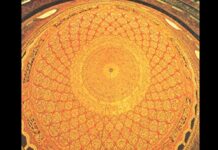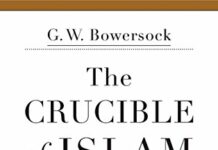
Ebook Info
- Published: 2013
- Number of pages: 208 pages
- Format: PDF
- File Size: 2.78 MB
- Authors: G.W. Bowersock
Description
Just prior to the rise of Islam in the sixth century AD, southern Arabia was embroiled in a violent conflict between Christian Ethiopians and Jewish Arabs. Though little known today, this was an international war that involved both the Byzantine Empire, which had established Christian churches in Ethiopia, and the Sasanian Empire in Persia, which supported the Jews in what became a proxy war against its longtime foe Byzantium.Our knowledge of these events derives largely from an inscribed marble throne at the Ethiopian port of Adulis, meticulously described by a sixth-century Christian merchant known as Cosmas Indicopleustes. Using the writings of Cosmas and a wealth of other historical and archaeological evidence from the period, eminent historian G. W. Bowersock carefully reconstructs this fascinating but overlooked chapter in pre-Islamic Arabian history. The flashpoint of the war, Bowersock tells us, occurred when Yusuf, the Jewish king of Himyar, massacred hundreds of Christians living in Najran. The Christian ruler of Ethiopia, Kaleb, urged on by the Byzantine emperor Justin, led a force of 120,000 men across the Red Sea to defeat Yusuf. But when the victorious Kaleb–said to have retired to a monastery-left behind weak leaders in both Ethiopia and Himyar, the Byzantine and Persian empires expanded their activity in the Arabian territory. In the midst of this conflict, a new religion was born, destinedto bring a wholly unanticipated resolution to the power struggle in Arabia.The Throne of Adulis vividly recreates the Red Sea world of Late Antiquity, transporting readers back to a remote but pivotal epoch in ancient history, one that sheds light on the collapse of the Persian Empire as well as the rise of Islam.
User’s Reviews
Editorial Reviews: Review “[O]n the whole this book offers an intriguing and useful introduction to the history of a relatively obscure but certainly important region of the ancient world.” –Journal of Early Christian Studies”The Throne of Adulis shows Bowersock at full bent… Bowersock has brought a novel freshness to this grand narrative. He fastens with delight on new pieces of evidence, from each of which he derives conclusions that significantly alter our view of the whole story…Bowersock has taken us back to a moment of time when the future of the Middle East still hung in the balance…the pre-Islamic Middle East, Arabia, and the Red Sea have been thrown open for us by Glen Bowersock.” –Peter Brown, New York Review of Books “[A] splendid new book.” –Peter Thonemann, Times Literary Supplement”G W Bowersock amply achieves his aims in a most elegant fashion…. My summaries cannot convey the intense delight of reading The Throne of Adulis, which so lightly steps from language to language to delineate and richly explain its fragments of evidence, the implications of which accumulate into explanations of poorly known yet momentous events. G W Bowersock’s latest is no more than an extended essay yet it outranks many multi-volume treatises.” –Edward N Luttwak, Literary Review”This highly erudite study makes a noteworthy and heavyweight contribution to a complex subject. It does so in an unfussy and discreet manner that belies the impact it will have for scholars working in this field.” –Peter Frankopan, History Today”Bowersock brilliantly weaves together a sixth-century description of a now lost marble throne from modern Eritrea with new scholarship on Ethiopia and South Arabia in Late Antiquity, with fascinating results for the perennial problem of Islamic origins.” –Averil Cameron, author of The Mediterranean World in Late Antiquity”Bowersock probes the complexities of pre-Islamic Arabia and finds flourishing Jewish and Christian communities at each other’s throat, and pagans of monotheist bent. An ingenious, cutting-edge book, with answers for those wondering who needed the Qur’an’s Third Way.” –Garth Fowden, author of The Egyptian Hermes”Closely argued on scarce evidence, [The Throne of Adulis] draws attention to the enduring geopolitical significance of this poorly understood region. Recommended.” –CHOICE About the Author G. W. Bowersock is Professor Emeritus of Ancient History at the Institute for Advanced Study, Princeton, New Jersey. Among his many previous books are From Gibbon to Auden: Essays on the Classical Tradition, Mosaics as History: The Near East from Late Antiquity to Islam, and Roman Arabia.
Reviews from Amazon users which were colected at the time this book was published on the website:
⭐It is not well known but before the advent of Islam during a time of upheaval and war between the Persian Empire and the Byzantines, there was a militant Jewish Kingdom in Southern Arabia. This kingdom was called the Himyarite and it’s location was in Yemen. I have always been fascinated with Yemen and all aspects of its culture, including their own minorities the Yemenite Jews.Across the Red Sea from this kingdom was Ethiopia, whose capital was in Axum. They were a Christian country. Back in those times most Christians were allied with the Byzantines while Pagan were divided. The Jews both in Israel/Palestine and Yemen were allied with the Persians. This Christian country would eventually over take the Jewish Kingdom of the Himyarites. It was these event that would help lead up to the ad vent of Islam. Seems that everyone back then was rather hardline.Prior to full independence the Himyarite were dominated by the Kingdom of Axum. The reason why Axum left the Himyarites was that problems were brewing in Ethiopia. This enabled the Himyaarite to taste some freedom for a bit. But there was always Christian agitation, and the fomentation of rebellion. Christians acts of terrorism were occurring on Jewish Himyarite soil. So Joseph Dhu Nawwas retaliated by storming Najran and locking all the Christians in a Church and burning it with them inside. This sparked the Axumite invasion of Himyar.The main account of this invasion was told by a travelling historian named Cosmas several years after the invasion and by then the Himyarites were pretty much history. King Kaleb king of Axum. Sat on a throne that was located in Adulis. Adulis was some 20 miles north of an Ethiopian harbor that emptied into the say and south from the capital of Axum. The throne had inscription that praised the king. The inscription were also in greek and had some documentation of Ptolemaic invasions of Palestine and and Mesopotamia. The Pagan Ethiopians prayed to a war god named Mahrem, a war god comparable to Aries. The inscriptions were in Greek. Apparently the Ethiopians were fond of these thrones.After Kaleb took over Himyar he retired to a Monastery. Everntually Abraha would take over Himyar by force and he was not the best leader. In either case the Himyarites never regained control of their land.Joseph Dhu Nawas fought back as well he could. Even erected a chain to stop the incoming ships. He would be last seen riding his horse into the sea. It is rumored that the Ethiopians were assisted by byzantine troops. Persian reinforcements never arrived to help their Jewish allies. Persia had control of it’s lands and some Arab tribes in the peninsula. Byzantium had Palestine, Egypt and their own territory. To bolster their control there was some assistance given to the new religion of Islam from the Byzantine.All this set the stage for the coming of Islam. There was more then one hajira. The most well known is when Muhammad fled Mecca and went to Medina. The secend was when followers of Muhammad went to Axuman many remained there.The book is short and scholarly. Most of the sources are in Syriac and are almost untrackable or too expensive to get a hold of. This does not detract from the scholarly value of the book. It is only 150 pages worth of information and over half the book is footnote. If you are expecting a long read you will be disappointed.
⭐This slender book (133 pages of body text) is divided into nine chapters. The first five trace the history of various regimes in Ethiopa. One chapter deals with the rise of the Arab-Jewish kingdom of Himyar, mostly through an analysis of the Ethiopan regimes that preceded it. The actual overthrow of that kingdom by an Ethopian king is the topic of the next chapter. Final two chapters deal with the role of the Byzantine and Persian empires in this area of the world, and the way in which the history recounted in the book form the context for the development of Islam. In other words, one learns very little about the actual conflict itself, and even less about Himyar. For this reason you don’t quite get the story which the book promises.This is not a volume which presents a vivid reconstruction of a time and place that many readers will find exotic, relegating the scholarly apparatus to footnotes. Rather, the book puts epigraphy front and center, and scrupulously refuses to imagine or extrapolate life in the time described. It is clearly written, but if you do not nod your head at references to Apollonius of Tyanna or enjoy reading sentences like “it is in Sabaic epigraphy of the early third century that the earliest attestations of the presence of Axumite forces in this region occur” then this book is probably not for you.I personally enjoyed The Throne of Adulis and learned — in fact, I read it straight through from beginning to end in about three hours. But I am the kind of person who reads the Bulletin of SOAS and thinks “this looks so interesting — if only they would pull the camera back a bit and show the bigger picture to nonexperts like me”. So… yeah…This book appears in Oxford’s “Emblems of Antiquity” series, which is designed to produce short, readable accounts of antiquity for the educated reader. While I liked this book, I think it is important to understand that it really fails to meet the goals of the series, is far too specialized, and fails to cover the story that the editors clearly intended it to. I think this is a case where the press imagined a very different book than the one it got from its author. Bowersock, of course, is a senior scholar who deserves enormous contributions for his contributions to the scholarship on this area. And, as I said, I liked the book. I just think its important to warn the reader that this is not a light popularization, nor is it really focused on the conflict between Jewish and Christian kingdoms.
⭐This is a short but valuable and fascinating book (only 133 pages with another 9 pages for the appendix). I wish it had been longer because the story being told and the way it was told made me want to learn more. This was reinforced by the fact that, until quite recently, there were few books about what was happening South of the Roman Empire and the Sassanian one between the third and the sixth century AD.The book also has a very narrow focus. The events contained in the book are those that are mentioned on a now lost marble throne which was set up at Adulis. The inscriptions, however, were not lost because they were copied by a sixth-century Christian merchant. Other inscriptions on similar stone thrones which were ex votos are presented by Bowersock and, together, they provide the basis for his short overview of the history of Axum from the times of Ptolemy III (mid-century BC) to the first Arab conquests.By and large, the story is somewhat fascinating because it is little known. It is also told quite rigorously, based on epigraphic evidence and sources and this is also why you get only glimpses of it. There are not Tom Holland style interpretations to be found here and although some may feel that it makes the story somewhat “dry”, it also makes it less far-fetched, even if, at times, the author does tend to repeat himself.While the expansion of the Kingdom of Axum (roughly modern Erithrea and parts of Ethiopia) in all directions is retraced and explained, one of the most interesting parts is its growing involvement with Southern Arabia (roughly modern Yemen and Oman). Through epigraphy, several occupations of the Arab kingdom of Himyar can be recorded, both before and after the Kings of Axum adopted Christianity. Although not the core subject of this book, the author does emphasize the importance of controlling the trading ports on both sides of the Red Sea, and controlling the trade coming from Ceylon and India.Another key point made by the author is that the Kings of Axum developed an imperialist irredentism towards what is now Yemen and that this tension was further exacerbated during the fourth century when they became Christians whereas Himyar, in addition to pagan Arabs, developed Jewish and Christian communities. The former communities sought the protection and support of the Persians. The Kings of Axum were self-appointed protectors of the Christians and received the support of the Eastern Roman (or Early Byzantine) Empire.Tensions built up until, in the reign of Justin 1st (the uncle of Justinian), the Jewish king of Himyar tried to force the Christians to convert and persecuted and massacred at least some of the Christian communities in his Kingdom on what seems to be have been a rather large scale. This triggered an invasion from Axum, the conquest of the Kingdom of Himyar in 525 and a period of some forty years where the Christians dominated before the Persians took control. Finally, the last chapter of this little book (titled “Reckoning”) is focused on the beginnings of Islam and the influence that these upheavals are more than likely to have had on it.For me, this book was well worth four stars. Although I would have wanted a bit more “meat on the bones” to give it five stars, it certainly made me want to learn more about this period and region. Fortunately, both seem to have become increasingly fashionable among historians nowadays.
⭐I bough this book hoping it would provide straightforward facts. I was not disappointed. It is a great research and presents information on Christianity in Africa and the power Africans wielded over the Red Sea. It also shows that their was clear cooperation between the Greeks and Africans especially when conducting foreign expeditions.
⭐Emeritus Professor Bowerstock has given us a magisterial example of historical research and epigraphy of an area and a history that I knew nothing about. It has certainly given me a new understanding of the near middle east at the time of the birth of the Prophet, as well as a deeper understanding of the arrival of Christianity in Ethiopia in the ealry 6rth Century CE
⭐I found this interesting, It is a period of history and part of the world is not widely known, and I would like to learn more about it.
⭐It was new to me. An Axumite and christian kingdom in Ethiopia and a jewish kingdom, Himyahr, in Yemen, at war at the eve of Islam.I already recommend this book to others.
Keywords
Free Download The Throne of Adulis: Red Sea Wars on the Eve of Islam (Emblems of Antiquity) 1st Edition in PDF format
The Throne of Adulis: Red Sea Wars on the Eve of Islam (Emblems of Antiquity) 1st Edition PDF Free Download
Download The Throne of Adulis: Red Sea Wars on the Eve of Islam (Emblems of Antiquity) 1st Edition 2013 PDF Free
The Throne of Adulis: Red Sea Wars on the Eve of Islam (Emblems of Antiquity) 1st Edition 2013 PDF Free Download
Download The Throne of Adulis: Red Sea Wars on the Eve of Islam (Emblems of Antiquity) 1st Edition PDF
Free Download Ebook The Throne of Adulis: Red Sea Wars on the Eve of Islam (Emblems of Antiquity) 1st Edition





